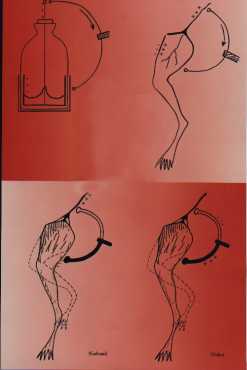The Galvani–Volta debate starts in 1792, after the publication of the De viribus... Galvani hypothesizes the existence of an “intrinsic animal electricity”, which, circulated by an external bimetallic arc, produces the contraction of muscles. For Galvani the frog muscle, besides being a very sensitive detector, is a reservoir of electricity which flows through the nerves and which works as a Leyden jar.
Volta reads the De viribus: surprised by Galvani’s results, he repeats the same experiments. But then he changes his interpretation from that of Galvani. On the basis of new experiments, Volta focuses on the bimetallic arc which connects the nerve to the muscle and intensifies the phenomenon; he convinces himself of the presence of an artificial electricity due to the bimetallic arc, which he considers as “motors of electricity”. He synthesizes his ideas in the phrase: “It is the metal diversity which makes”.
 1) Front page of Galvani’s De viribus...
1) Front page of Galvani’s De viribus... 2) Galvani’s analogy between a Leyden jar and a frog leg. Connecting the center pole of the Leyden jar with its outer armature by means of a metallic arc a discharge is produced. Similarly connecting a nerve with a muscle causes the contraction of the leg.
3) Comparison of Galvani’s and Volta’s theories. For Galvani the nerve and muscle are electrically unbalanced; the connection brings the electric fluid in balance generating the contraction; the arc is only a passive conductor. For Volta the bimetallic arc has an active function as electromotor: the contact of the arc moves the electric fluid whose current generates the contraction.
